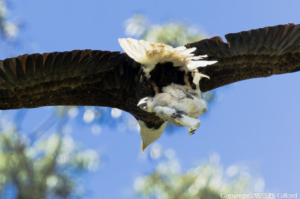What the Vaux swift lacks in size it makes up for in numbers.
The smallest species of the swift family has chosen a chimney at a boarding school in Healdsburg as the spot to rest for a few days and tank up on insects before proceeding South for the winter.
The swifts began arriving at Rio Lindo Adventist Academy last week, as they’ve done every year since 1989. About 250 individuals were spotted over the weekend, and they’ll peak at 5,000 to 10,000 for a couple nights in mid September.
“It’s pretty amazing,” said Brad Benson, the school’s development director, who keeps track of the annual phenomenon.”Once it gets up to 2,000 to 4,000 birds or more, they start gathering and swirling around in the sky, and if predators are not disturbing them it will look like a vortex or tornado funneling down into the chimney.”
Just why the Vaux’s swift (pronounced “vawks”) likes this particular Healdsburg chimney is a bit of a mystery. But like their close cousins, the chimney swift, they’ve found amiable habitat in human structures. The academy’s boiler chimney is 32 feet high and has a 54 square inch opening — enough space, apparently, for the swifts to communally roost when the temperature drops at night (The boiler is not running at this time of the year).
Benson said one Santa Rosa biology teacher videotaped the descent during the flock’s peak and estimated that about 350 birds per minute were entering the chimney.

It’s rare, indeed, that anyone sees such large numbers of birds swarming these days. In 2008, the highest numbers ever were observed at the school — 20,000 birds showed up. The Vaux’s swift event at Rio Lindo has become lore among birders and locals. Several hundred people set up lawn chairs and watch the descent at dusk when the numbers reach 2,000 and up.
“I’ve had people calling in from out of state to ask me when the peak usually is because they’re planning a trip from Florida,” said Benson.
Efforts to track the species have been difficult. The swifts come from southern Alaska, British Columbia and Washington state, and often roost in the same landing spots. But no one knows whether they stop in Mexico, or continue on to South America. They forage in fast flight, capturing small flying insects, sometimes called “aerial plankton.”
In nature, they would be roosting in the hollow of a tree, but with the loss of habitat they’ve increasingly made camp at manmade structures. Benson said when the numbers peak, he’s seen the birds start their descent earlier, about a half hour before sundown, so that they all make it in before the nighttime chill hits.
At peak, they also draw predators. Merlins, a species of falcon, prey on the Vaux’s swifts.
“When the merlins show up, often times their attacks disrupts the entry into the chimney and will break if off a couple minutes, so that can lengthen the amount of time it takes to get in,” Benson said.
Go check out the Vaux’s swifts this year. Just a few pointers on watching the spectacle:
- Check Benson’s status update and for the best viewing head out there when the numbers of swifts reach above 2,000.
- Get there a half-hour before sundown.
- This is a boarding school, so no smoking and no alcohol.
- Parking is a-plenty.
- Location: the south side of the campus just west of gym and ballfield. 3200 Rio Lindo Ave., Healdsburg.
The Santa Rose Press Democrat created this video in 2010 of the Rio Lindo swifts.
Check out this video of Vaux’s swifts descending into a school chimney in Portland, Oregon.





